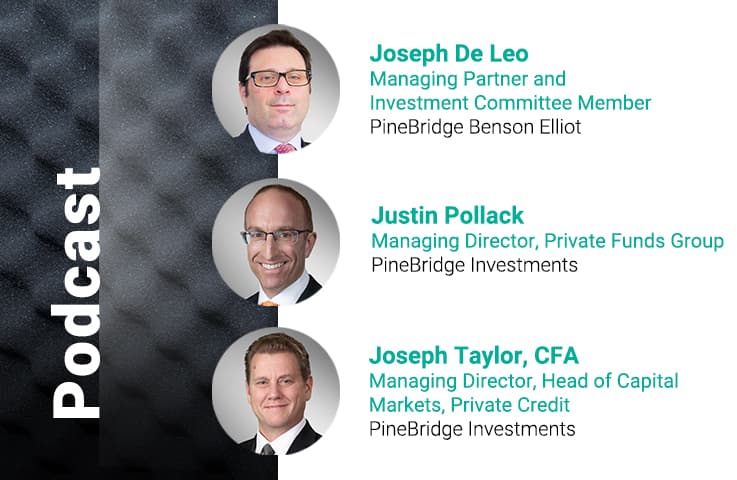Private Equity Dry Powder Is Still Elevated. Should Investors Be Worried?

Justin Pollack
Managing Director, Private Funds Group

Cora Chen, CFA
Senior Analyst, Private Funds Group
A surplus of uninvested capital can weigh down private equity fund managers, who typically charge fees based on commitments, with failure to invest this capital implicitly raising the cost of the money invested. Yet the limited window to make new investments can pressure them to pursue opportunities aggressively, often bidding up prices in competitive auctions.
Middle market funds have exhibited more stable levels of dry powder than large market funds, which contributes to a more stable and less volatile market environment, especially during periods when credit markets tighten with increasing lending restrictions.
We believe investors should not be overly concerned about the rise in dry powder, especially in the middle market, which can yield potentially better investment opportunities due to lower valuations, less competition, higher growth potential, and diverse exit strategies.

“Federal Reserve Hikes Rates Again Amid Inflation Concerns.” “Central Banks Grapple with Economic Uncertainty.” “Global Supply Chain Disruptions Continue to Impact Markets.” Throughout 2023, headlines like these reflected the key developments driving the financial industry, and private equity companies felt the impact of the same forces. Many modified their acquisition strategies in response to the elevated cost of capital and economic uncertainty, as shown by a 45% drop in the number of buyout transactions from 2021’s peak (see chart). Over the same period, buyout funds’ dry powder, defined as the amount of cash that a private equity firm reserves, surged by 25%.
What does this rise in dry powder mean for the private equity industry, and how concerned should investors be?
Private Equity Dry Powder Surged as the Number of Transactions Dropped

Source: Preqin database, retrieved 11 June 2024. Represents 9,163 buyout funds in Preqin database closed from 1 January 2019 to 31 December 2023.
The consequences of growth in dry powder
The surplus of uninvested capital can become a weight around the neck of private equity fund managers. Since they typically charge fees based on commitments, failure to invest this capital implicitly raises the cost of the money that was invested. Yet the limited window to make new investments compounds the pressure on these firms and can force them to pursue opportunities aggressively, often bidding up prices in competitive auctions.
When attractive investment targets are scarce, prices inevitably rise. Consequently, as more funds compete for a limited pool of assets, the PE market experiences an inflationary effect on purchase multiples, reflecting the increased willingness of investors to pay premiums for quality acquisitions in a competitive landscape shaped by substantial dry powder reserves.
In 2023, middle market buyouts, which we define as transactions under $1 billion, had an 8.8x average enterprise value/EBITDA multiple.1 Large market buyout multiples are higher, at 11.6x on average. When there is not an excess of uninvested capital, competition for a given deal remains low and investors are less likely to see inflated valuations. This makes middle market deals relatively more resilient during market conditions like we’re seeing today.
Furthermore, the increasing amount of dry powder has a notable impact on fundraising activities among investment firms and entities. From 2021 to June 2024, the global private equity market has experienced a sharp decline in the number of buyout funds raised, while the average fundraising time per fund remains prolonged (see chart). The surplus of uninvested capital signals a period of cautious investor sentiment, prompting a slowdown in fundraising efforts.
Fundraising Timelines Have Increased as the Number of Deals Dropped

Source: Preqin database, retrieved 20 June 2024. Represents 2,665 buyout funds in the Preqin database from closed 1 January 2019 to 19 June 2024. YTD 2024 represents data from 1 January 2024 to 20 June 2024.
With ample funds already at their disposal, investors may adopt a more conservative approach, prioritizing strategic deployment of existing resources over actively seeking new capital. Private equity firms proactively initiate restructuring activities within their existing portfolio companies to optimize performance in a high interest rate and high labor cost market. This involves operational improvements, strategic realignments, or financial restructuring. Moreover, all-cash transactions have become popular in the larger market with more dry powder, as they provide certainty of funds and a faster closing timeline compared with deals involving financing contingencies. All-cash deals also mitigate risks associated with financing, such as market volatility, interest rate fluctuations, or credit availability. These phenomena explain the decreased fundraising activity as firms turn their focus toward optimizing the utilization of available funds rather than expanding their capital base.
The middle market: a less volatile space
When we look under the hood at the sharp decrease in buyout transactions, we find that middle market buyouts witnessed a 33.1% drop in number from 2021 to 2023, versus a 42.5% drop for larger market transactions.2 We define the middle market as funds with less than $2 billion in commitments or transactions with less than $1 billion of enterprise value (see our thought piece “Why the Middle Market Can Beat Out Large-Caps in Private Equity Investing” for more information).
Large market buyout transactions involve bigger companies with higher valuations and more complex deal structures. Conversely, middle market transactions involve smaller companies with lower valuations and attract less competition. As the chart below shows, middle market funds have exhibited more stable levels of dry powder than large market funds, which experienced a 19% increase in dry powder from 2021 to 2023. Slower dry powder growth contributes to a more stable and less volatile market environment, especially during periods when credit markets tighten with increasing lending restrictions. Middle market companies tend to have more access to capital, as they often have less-complex organizational structures and operations than large corporations.
Large Market Dry Powder Has Increased More Rapidly vs. the Middle Market
(US$ bil.)

Source: Preqin database, retrieved 18 July 2024. Represents buyout funds in Preqin database closed from 1 January 2019 to 31 December 2023. Middle Market buyout funds represent funds with less than $2 billion of committed capital. Large market buyout funds represent funds with above $2 billion of committed capital.
Pressure to invest: Is it truly a concern?
Holding large amounts of capital creates pressure on private equity firms to invest quickly to generate returns and keep capital from sitting idle. As discussed earlier, the heightened urgency may compel investors to expedite due diligence processes and make quick investment decisions, sometimes overpaying for an acquisition. However, holding on to cash for long periods can erode potential returns due to inflationary pressures, adding further urgency to deploy.
These tendencies may be a legitimate cause for concern for investors, but raise a related question: Are investors really under pressure to deploy quickly?
Looking further into the drivers behind the rise in dry powder, 2022 vintage buyout funds have the most, followed by the 2023 and 2021 vintages. The investment period of a typical private equity buyout fund usually lasts six years. This implies that fund managers of the 2021-2023 vintages need not rush and have time to deploy capital patiently, with a focus on long-term value creation.
2022 Vintage Buyouts Have the Most Dry Powder, Followed by 2023 and 2021
Dry powder vs. unrealized value by vintage year (US$ bil.)

Source: Preqin database, retrieved 20 June 2024.
Though higher levels of dry powder increase competition and push up pricing, while creating more risk of overpaying and delaying fundraising activities, they can also benefit several strategies – namely outside North America.
Looking outside North America
Ongoing increases in market interest rates have created additional opportunities for North American private equity firms to purchase overleveraged companies at a discount. North America witnessed a 20% increase in dry powder from 2020 to 2023, whereas other regions remained relatively flat over the same period, with only an average 5% increase (see chart). In 2023, North America maintained the lion’s share of dry powder, at 63%, providing these firms with opportunities to acquire highly leveraged companies in Europe, Asia, and other markets that are facing floating interest rate pressures.
Dry Powder Has Increased Most Dramatically in North America
Dry powder by region (US$ bil.)

Source: Preqin database, retrieved 20 June 2024. Represents dry powder in Preqin database from 1 January 2014 to 31 December 2023. YTD 2024 represents data from 1 January 2024 to 20 June 2024.
A signal of recovery
North America’s private equity buyout market has witnessed signs of recovery, with available dry powder decreasing by 1.1% from December 2023 to June 2024.3 This reduction indicates that private equity firms are actively deploying capital, seizing new investment opportunities, and optimizing their portfolios, marking a shift in market conditions and investor confidence. We believe this trend highlights a robust and dynamic investment environment in which capital is efficiently directed toward fostering growth and generating value.
For the middle market in particular, the rise in dry powder and its impacts have been more muted. We believe investors in this segment have little reason for concern, especially when the middle market can yield potentially better investment opportunities due to lower valuations, less competition, higher growth potential, and diverse exit strategies.
These factors lend support to our approach to private equity investing, which focuses on opportunities in the lower middle market – with an aim to evaluate compelling assets with precision and a strategic focus on finding real value.
1 Source: FactSet as of 31 December 2023. Represents all announced acquisitions globally.
2 Pitchbook database, retrieved 20 June 2024. Represents completed buyout transaction in Pitchbook database from 1 January 2021 to 31 December 2023.
3 Preqin database, retrieved 20 June 2024. Represents dry powder in Preqin database from 31 December 2023 to 20 June 2024.
Disclosure
Investing involves risk, including possible loss of principal. The information presented herein is for illustrative purposes only and should not be considered reflective of any particular security, strategy, or investment product. It represents a general assessment of the markets at a specific time and is not a guarantee of future performance results or market movement. This material does not constitute investment, financial, legal, tax, or other advice; investment research or a product of any research department; an offer to sell, or the solicitation of an offer to purchase any security or interest in a fund; or a recommendation for any investment product or strategy. PineBridge Investments is not soliciting or recommending any action based on information in this document. Any opinions, projections, or forward-looking statements expressed herein are solely those of the author, may differ from the views or opinions expressed by other areas of PineBridge Investments, and are only for general informational purposes as of the date indicated. Views may be based on third-party data that has not been independently verified. PineBridge Investments does not approve of or endorse any republication of this material. You are solely responsible for deciding whether any investment product or strategy is appropriate for you based upon your investment goals, financial situation and tolerance for risk.


